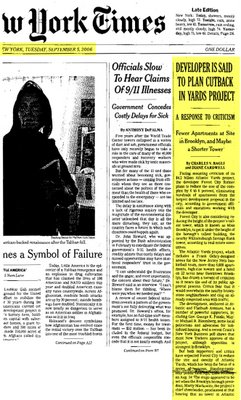From the New York Times's profile yesterday of developer Sheldon Solow, headlined Towering Vision by Developer Stirs East Side:
Months ago, he also cut the height of his proposed towers. His critics, however, contended that Mr. Solow had, in the time-honored tradition of New York developers, requested more than he wanted knowing that he could later shave their size to appear to be willing to compromise.
 Such wisdom did not appear in the front-page lead story on 9/5/06 about Atlantic Yards, headlined Developer Said to Cut Size of Brooklyn Project, which called the move "A Response to Criticism" rather than a tactic, and failed to point out that the project would remain, in square feet, the same size as originally planned.
Such wisdom did not appear in the front-page lead story on 9/5/06 about Atlantic Yards, headlined Developer Said to Cut Size of Brooklyn Project, which called the move "A Response to Criticism" rather than a tactic, and failed to point out that the project would remain, in square feet, the same size as originally planned.
Instead, the piece put the onus on the "most severe critics":
Whatever happens, the planned cutbacks are unlikely to satisfy the most severe critics.
“I don’t think the bottom-line community concern is really about aesthetics, which is what shaving a few stories off the heights of the buildings is about,” said James F. Brennan, a Brooklyn assemblyman. “I don’t think this flies.”
Daniel Goldstein, a spokesman for Develop Don’t Destroy Brooklyn... said he suspects that the developer has had this proposal “in their closet for a long time.”
Next-day rowback
A follow-up article the next day, headlined Developer’s Plan for a Smaller Yards Project Matters Little, More or Less, in Brooklyn, offered some basic wisdom missing from the previous lead story:
The pattern of changes so far has fueled speculation in some circles that Forest City is merely following the tried and true developers’ tactic of building a cushion against inevitable calls for downsizing from planners, politicians and residents of the surrounding neighborhoods.
“With practically every large development project, people ask for far more than they need,’’ said Ron Shiffman, a former member of the New York City Planning Commission, who recently joined the advisory board of Develop Don’t Destroy Brooklyn, an umbrella organization for groups opposed to the project. “The city is never really very good at setting their own standards and criteria for scale.”
Mr. Shiffman speculated that the small reductions being contemplated are “more of a show than a substantive reduction,” aimed at politicians who do not want to stop the project but do want to claim credit for having gained concessions from the developer. “This is similar to the playbook and strategy that Ratner has used for all of his developments,” Mr. Shiffman added. “I think this is predictable, and that they concluded that the politicians needed something to go back to their constituents with.”
But the damage had already been done. The Times stonewalled my complaints, but they obviously aren't making the same mistakes as often.
Months ago, he also cut the height of his proposed towers. His critics, however, contended that Mr. Solow had, in the time-honored tradition of New York developers, requested more than he wanted knowing that he could later shave their size to appear to be willing to compromise.
 Such wisdom did not appear in the front-page lead story on 9/5/06 about Atlantic Yards, headlined Developer Said to Cut Size of Brooklyn Project, which called the move "A Response to Criticism" rather than a tactic, and failed to point out that the project would remain, in square feet, the same size as originally planned.
Such wisdom did not appear in the front-page lead story on 9/5/06 about Atlantic Yards, headlined Developer Said to Cut Size of Brooklyn Project, which called the move "A Response to Criticism" rather than a tactic, and failed to point out that the project would remain, in square feet, the same size as originally planned.Instead, the piece put the onus on the "most severe critics":
Whatever happens, the planned cutbacks are unlikely to satisfy the most severe critics.
“I don’t think the bottom-line community concern is really about aesthetics, which is what shaving a few stories off the heights of the buildings is about,” said James F. Brennan, a Brooklyn assemblyman. “I don’t think this flies.”
Daniel Goldstein, a spokesman for Develop Don’t Destroy Brooklyn... said he suspects that the developer has had this proposal “in their closet for a long time.”
Next-day rowback
A follow-up article the next day, headlined Developer’s Plan for a Smaller Yards Project Matters Little, More or Less, in Brooklyn, offered some basic wisdom missing from the previous lead story:
The pattern of changes so far has fueled speculation in some circles that Forest City is merely following the tried and true developers’ tactic of building a cushion against inevitable calls for downsizing from planners, politicians and residents of the surrounding neighborhoods.
“With practically every large development project, people ask for far more than they need,’’ said Ron Shiffman, a former member of the New York City Planning Commission, who recently joined the advisory board of Develop Don’t Destroy Brooklyn, an umbrella organization for groups opposed to the project. “The city is never really very good at setting their own standards and criteria for scale.”
Mr. Shiffman speculated that the small reductions being contemplated are “more of a show than a substantive reduction,” aimed at politicians who do not want to stop the project but do want to claim credit for having gained concessions from the developer. “This is similar to the playbook and strategy that Ratner has used for all of his developments,” Mr. Shiffman added. “I think this is predictable, and that they concluded that the politicians needed something to go back to their constituents with.”
But the damage had already been done. The Times stonewalled my complaints, but they obviously aren't making the same mistakes as often.
Comments
Post a Comment